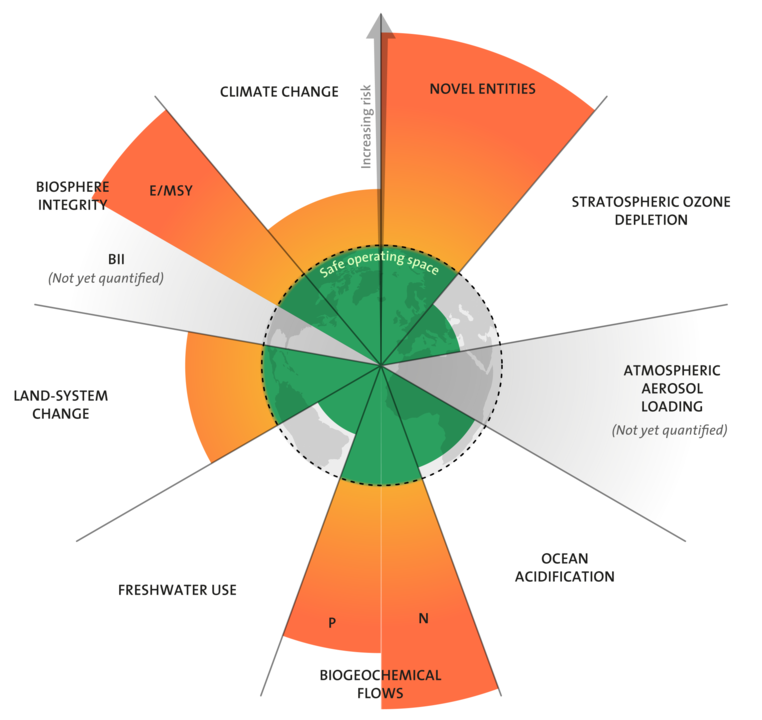Breaking Down: The UN's Global Assessment Report

In late April, the United Nations released their Global Assessment Report on Disaster Risk Reduction. This is not related to the IPCC report on climate change, although the two are similarly comprehensive and, unfortunately, similarly alarming. For whatever reason, this report has not made as many waves as the IPCC reports do, perhaps in part because of the nature of the report–it's accessibly written but rather dry, and the focus of the report is on how to think about, communicate, and address risk rather than the flashier focus on risks themselves. Despite this, the report is fairly clear on the point that we are on a path toward societal collapse–even if the report rarely seems to say so with the expected gravity.
The report, of course, talks a lot about climate change and the overall increase in disasters the world is experiencing. It talks about cascading disasters and risk mitigation. It does a great job of laying out a framework for moving forward by presenting COVID-19 as a case study, showing how a changing world had allowed the virus to jump to people, spread into a pandemic, and how wrongheaded thinking and choices led to the pandemic's mismanagement. One of its central ideas is the "risk perception gap"–which is sort of ironic given that it brings up the concept of collapse without addressing such a risk appropriately. With that in mind, today we'll talk about some other key concepts in the report as they pertain to collapse, in particular a set of risks that the report refers to as planetary boundaries, the Sendai Framework, how the report suggests we change our thinking to respond appropriately to the threats we face, and where it seems to fall short.
Planetary Boundaries
Planetary boundaries are the metric by which the report measures the looming threats we are facing–or not facing–across the planet. These boundaries are the thresholds of change within a given component of the world's ecosystem, or the broad addition or subtraction of something to those systems, which can occur in a kind of equilibrium or disruption. The planetary boundaries are meant to analyze the risk associated with human intervention within these components. Once a boundary is crossed, the possibility for abrupt and catastrophic change occurs. (It'll make more sense with examples.)
There are nine planetary boundaries recognized:
- Climate Change
- Biodiversity Loss/Biosphere Integrity
- Biogeochemical (The use of nitrogen and phosphorus)
- Ocean Acidification
- Land Use/Land System Change (areas left unspent by agriculture)
- Freshwater
- Ozone Depletion
- Atmospheric Aerosols
- Novel Entities (Manmade pollutants like microplastics, radioactive waste, and PFAS)
Remaining within the boundaries in each category means that the planet is balanced–essentially, this means that humankind is able to advance and develop in a sustainable manner. Unfortunately for us, we've already crossed five of these boundaries, and two of the remaining categories have not been fully quantified.

Each exceeded boundary presents us with the possibility of disaster, and each exceeded boundary has the potential to push other boundaries further into dangerous territory. If this sounds familiar to you, it should; these planetary boundaries are frequently very similar to climate change tipping points we've addressed before, with each tipping point potentially knocking over the next. In fact, a few literally are climate change tipping points, as Land Use covers forests as carbon sinks, and Ocean Acidification and Biodiversity Loss can contribute to oceans becoming greenhouse gas factories.
The Sendai Framework and Sustainable Development
Another key component of the report is the Sendai Framework, a document agreed upon by the UN in 2015 that sets goals and priorities for disaster reduction. The framework is predictable, for the most part; goals include "understanding disaster risk" and "enhancing disaster preparedness for effective response," with an endpoint to the framework set in 2030. This 2022 report stresses that, with eight years left to meet the framework's goals, things are not looking good. Overall disaster-related deaths have increased in the past thirty years, though there has been a significant dip from 2010-2020. There has also been an increase in cost related to disasters, with poorer countries predictably bearing the brunt of disaster impacts. The good news is that UN data does, also predictably, bear out a reduction in cost and mortality for regions and countries that have disaster preparedness programs in place.
An important takeaway from the report is that disasters have increased and worsened in large part because of urbanization and development in at-risk regions, and that globalization and interconnectedness have led to systems being far more susceptible to cascading disaster. We can surely think of a dozen or so examples off the top of our head–supply chains are still a mess due to COVID-19, and the economies of nations around the world are destabilized by the war in Ukraine, frequently thousands and thousands of miles away. The GAR report highlights a great example in Thailand, which experienced extensive flooding in 2011. This flooding, which is well-documented throughout history, was particularly impactful because the Thai government had incentivized development in flood-prone regions due to existing infrastructure, disrupting manufacturers which in turn disrupted supply chains across the globe.
What this all boils down to is that human decision-making frequently exacerbates the impacts of disasters, from flooding to pandemics, due to a shortsighted focus on profit and political expedience. The recommendation of the report is to abandon this approach and current common risk management frameworks in favor of a long-term, holistic, systems-based approach.
Brass Tacks
Despite the report being over two hundred pages long, only about a page of it is devoted to the notion of what it refers to as "global collapse risk." Far more common is "system collapse," which is more akin to what we talk about on a daily basis–the Texas electrical grid failure two winters back, or supply chain failures. But the report does, in no uncertain terms, state the following:
When global collapse risk is analysed according to the nine planetary boundaries, scenarios that consider achievement of the SDGs and the Sendai Framework goal within the concept of planetary boundaries show a dangerous tendency for the world to move towards a global collapse scenario (Cernev, 2022).
Unfortunately, aside from the above quote and a graphic, that's about all we get from the report on the idea of big C Collapse–just that it seems like we're moving toward it. And while I'd love to see a nod toward degrowth in a report like this, that's obviously a longshot. The closest thing we get to it is the acknowledgement that their sustainable development goals "return to questions of sustainable consumption." And that the world's increasing rate of consumption is "accelerating the rate of change," increasing the risk of disaster and collapse.
The report's answer to risk reduction is not some bold innovation or paradigm-shift. In a way, it's the same as the mission of this newsletter: education. By educating governments about risk and how to think about sustainable development, they hope to mitigate and minimize the disasters that are headed our way. The report concludes by encouraging the acceleration of risk reduction, building resilience, and being comfortable with uncertainty. I find that a little wanting. To acknowledge the potential for cascading disaster, systems collapse, and the "tendency for the world to move towards a global collapse scenario," and then to end with a "call to action to accelerate risk reduction" seems almost willfully ignorant of the report's own contents. I won't pretend to be able to recommend what such a body do, but I do pretend to be able to say that "be more careful quicker" isn't quite as ambitious a goal as it should be.
I started in on this report intending on simply flagging a major publication that admits we're on the wrong track and, further, hints at the potential for global collapse. But reading through the report, I found myself geeking out on the subject despite myself. The work that these bodies do is inadequate but important, and in a world where we had more time, these ideas would be functional. In a way, they're utopian–if we just educate and invest, we can overcome an existential threat. And it's possible, I suppose, that if every government changed overnight we would stand a decent chance. But, well, look around you. We have to take care of ourselves and each other. The government is not going to save anyone in time.
